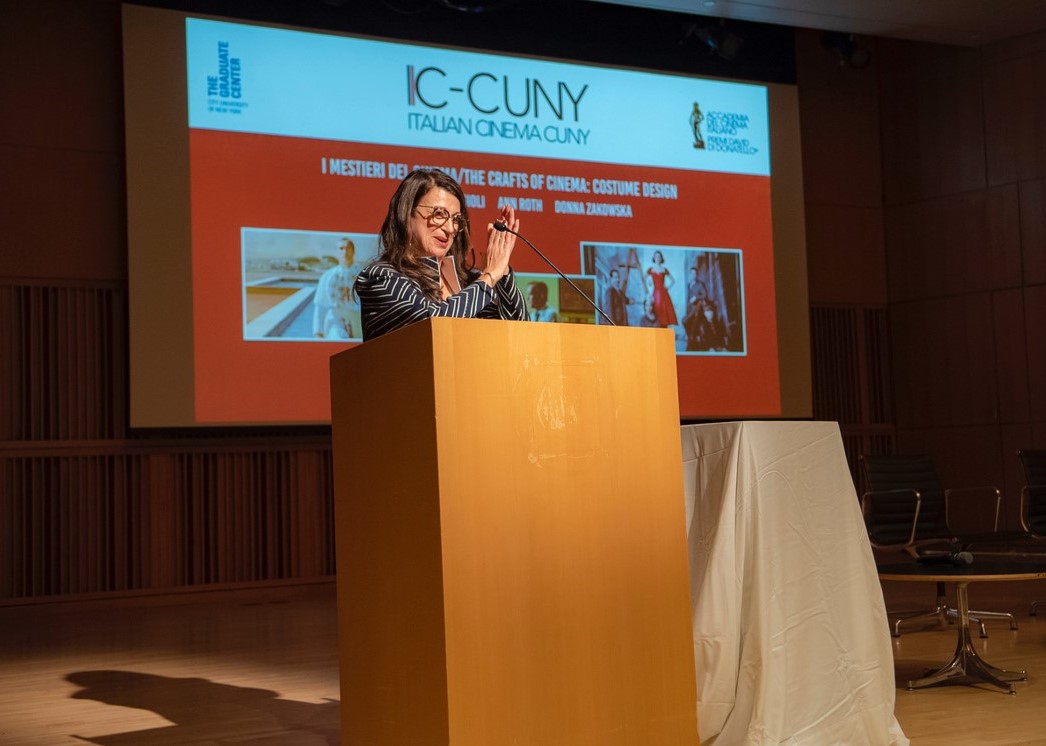
 Patricia Gatto Puglia
Patricia Gatto Puglia
Italian lifestyle and fashion: Three-part IC - CUNY (Italian Cinema - CUNY) Festival dives into the art and craft of cinema, costumes first
- WTI Magazine #121 Nov 17, 2019
-

 Patricia Gatto Puglia
Patricia Gatto Puglia
What happens when award-winning Italian and American costume designers get together on a university stage to discuss cinema, fashion and costume design? The audience is treated to a little slice of cinematic magic.
There’s the lively repartee between masters of the craft – costume designers who have created the wardrobes for the best-known movies of our day. There are anecdotes and behind-the-scene stories you probably haven’t heard before. There’s the perspective you glean from designers who have seen it all and helped create film magic. And let’s not forget the mash-ups of the designers’ best work that trigger memories of your favorite films.
Costume Design A-Team
All of this and more was in play this past Halloween night at the City University of New York (CUNY) Graduate Center’s Elebash Recital Hall when a sold-out crowd of students, academics, and actors, as well as fashion, costume and movie enthusiasts gathered to hear costume designers talk shop. On hand were legendary Oscar and Tony winner Ann Roth (The English Patient, The Nance, The Talented Mr. Ripley, Cold Mountain, Julie & Julia, The Post, Mama Mia, Midnight Cowboy), two-time Emmy winner Donna Zabowska (The Marvelous Mrs. Maisel and John Adams, Crimes and Misdemeanors, The Iceman, Fading Gigolo, The Jesus Rolls -- John Turturro’s soon to be released new film) and Emmy and David di Donatello award nominee Carlo Poggioli (The Name of the Rose, The Age of Innocence, Sparrow, Divergent, The Voice of the Moon, Federico Fellini’s final film, The Young Pope, The New Pope).
Master Class Kick-Off
The October 31 event kicked off the second edition of CUNY’s Academic Festival IC-CUNY (Italian Cinema – CUNY). This year the festival is presented this as a three-part series of Master Classes on the art and craft of film, with an emphasis on the interconnections – current and historical – between Italian and US cinema. IC-CUNY collaborated with The Academy of Italian Cinema David di Donatello (bestower of the David di Donatello awards -- the Italian equivalent of the Oscars) to develop the festival, marking the first partnership by the Italian organization with an American academic institution.
Eugenia Paulicelli, the founder and director of IC – CUNY, professor of Italian Studies, and a scholar of fashion and film, conceived and organized the festival, working with Massimo Mascolo, a consultant to the David di Donatello Awards and co-director for 2019 of the IC-CUNY festival.
Paulicelli framed the evening’s discussion in her opening remarks, noting the fundamental importance of costume designers to the making of films and the lasting effect costumes have on the “emotional imaginary.” She also pointed to the larger context of the IC-CUNY initiative – Italy’s and America’s long history of collaboration in film, beginning in the silent film era until today.
The parallels between the experience of the two countries are striking, what Paulicelli called a “two-way street” worked to transform the Italian identity. “Hollywood cinema launched American fashion to the world, and postwar Italian cinema launched Italian fashion during the magical time called Hollywood on the Tiber, when American actors and crews populated the streets of postwar Rome, newly christened the city of film and the city of fashion. American stars became ambassadors of Italian fashion and design.”
The Bulgari Connection
Picking up the history thread, Piera Detassis, president and artistic director of the Academy of Italian Cinema David di Donatello Awards, who was on hand in New York for the Master Class, told the audience that the Academy’s origins trace to a small cultural club, The Open Gate, formed by a group of Italian cinephiles in the immediate postwar period.
In 1956, the group had become the Academy of Italian Cinema and began to honor the best of each year’s Italian and foreign films. The Academy commissioned Bulgari to create the first gold David di Donatello statuette, awarding it to Gina Lollobrigida in 1956 for Best Actress for La donna più bella del mondo (released in the US as Beautiful but Dangerous). The audience was treated to a surprise look at the statute. Bulgari’s Monica Branetti, director of the jeweler’s heritage department and historical archive, had brought it to New York, on loan from Lollobrigida. In 1959, the award went to Marilyn Monroe. Detassis screened charming black and white footage of a news reel showing Monroe accepting the award in Italy.
Moving to the Panel
Paulicelli and Detassis moderated a discussion with the three costume designers on stage – Ann Roth, Donna Zabowska and Carlo Poggioli. (The fourth costume designer on the bill, four-time Oscar winner and David di Donatello winner Milena Canonero, was unable to attend at the last moment.) The designers recounted memorable moments from films they had worked on over the years, sometimes together, and mused about new challenges facing the industry, adapting to new technologies, accelerating production schedules in a Netflix world, and dealing with a shrinking pool of highly skilled, custom tailors.
Here are a few highlights of the conversation
The topic of finding the actor’s character came up in response to a question about the challenges inherent to the costume designer’s role. Poggioli was quick to respond that designers need to know “how to talk” – not just how to sketch and design and cut cloth. Increasingly, they need to act as “psychologist and sometimes psychiatrist!” to understand not the director’s vision or what the actor wants to accomplish with a costume or role, but also to navigate the whims of producers, who are increasingly driving decisions, including project timelines for costumes, from a budgetary standpoint.
Zakowska conceded that she” never thinks about budgets” primarily. Roth said she doesn’t even “know producers’ names.“ Zakowska said she learned to “immerse” herself in the “creative process,” first and foremost, at the Yale School of Drama, which is also the alma mater of John Turturro who was in the audience that evening. When asked what he thought about working with Zabowska on costumes for the many films they’ve done together, Turturro quickly said his mother was a seamstress and that he had been brought up surrounded by fabrics!
“Realistically I know what (Carlo) is saying, and I have done many films [on a shoestring] but your vision [as a costume designer] has to be detached.” She brings up Vittorio De Sica’s The Bicycle Thief as an example of how even the simplest costume is like a “visual poem.” “You have to think of the clothes as words and then the fabric follows.”
Roth interjected that the key to costume design is helping actors “find” their character. Often, they are more interested in “being themselves” and have to be coaxed to “free themselves” of their own egos. “It can take hours, or it can take days.” Take Dustin Hoffman in Midnight Cowboy. When Roth met Hoffman for the first time, he had just finished The Graduate. “All the girls were crazy about him, so naturally he was interested in looking pretty on screen.” In Roth’s eye, Hoffman’s Ratso Rizzo character “fantasized” wearing a white suit like Marcello Mastroianni wore in all the billboards, but Rizzo could never afford to buy one. But eventually, Rizzo got his white suit by way of a white jacket that came out of a “garbage can on 42nd Street and Eighth Avenue,” a leftover, says Roth, “from some kid who had been to a graduation where it had been spilled on or thrown up on.” The pants came from “a pile of dirty pants from in front of the Port Authority where they sold stuff. When Dustin stood in the fitting room, he didn’t see Dustin anymore, he was free to be someone else.”
The evening concluded with “an illustrated conversation” between Paulicelli and film producer Roberto Bessi,, who talked about Annamode, the legendary cinematic and theatrical costume workshop in Italy and the launch of a new fashion brand, Annamode1946.
Next up in the series
Part II: Contemporary Italian Cinema
November 13 at the CUNY Graduate Center and November 14 at Queens College.
Part III: Panel on Costume and Fashion, Cinema and Made in Italy
December 5 at the CUNY Graduate Center
Click to register and read more about the Master Class series and bios of the presenters.